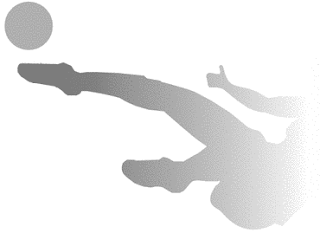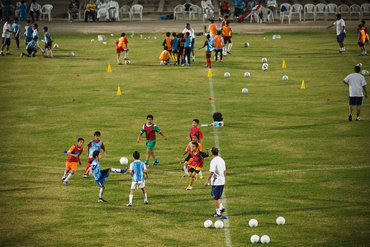Introduction
Ball control is the foundation for all aspects of the game and a source of motivation for young players because it feels good to be at ease with the ball.
The ability to control the ball is the key to many other skills, and juggling is also a very good way to practise ball control, getting familiar with the ball and gaining confi dence. Generally speaking, it is not difficult to master a technical skill, but it does become harder as the game conditions change.
Therefore, a player can only master the technique of controlling the ball if he coordinates the various parts of his/ her body. Furthermore, the learning aspect depends on the number of repetitions, whereas there are various combinations available in terms of the method to be used.
As a young player develops, his/her technical skills will set the foundations for good development and enable him/her to experience all of the joy that football can bring.
In grassroots football, the basic techniques can be divided into four categories:
- Controlling the ball
- Running with the ball
- Passing the ball
- Shooting
Controlling the ball
ControllingTo control the ball is to master it. Properly controlling the ball means that a move will be successful. The control movements to focus on are: directed control and gathering the ball while moving – these introduce speed into the play.
Juggling
If repeated regularly, juggling develops the skills of dexterity, coordination and balance in young footballers. These skills favour the more rapid acquisition of other techniques.
Running with the ball
This is how an individual moves in free space with the ball. When a player is running well with the ball, he/she is in control of it at all times: this requires good balance and excellent stability. Running with the ball while keeping the head up allows a continuous flow of information to be received and allows movement to be adapted to play.Dribbling
This is how an individual moves with the ball when faced by opponents/obstacles. Dribbling allows the player in possession of the ball to eliminate one or more opponents by:
- making a manoeuvre and taking individual risks;
- setting up a team move;
- gaining time to allow support from team-mates;
- deceiving an opponent (the concept of the feint).
Passing the ball
This is the action of giving the ball to a team-mate. It is an essential part of team play. As the core of the game, passing allows a team to:- keep possession of the ball;
- set up attacks;
- change the direction of play;
- counter-attack;
- provide a decisive or final pass.
Shooting
This is an action with the objective of dispatching the ball into the opponent’s goal. It is the logical conclusion, the culmination of an attack. It is what football is all about. Shooting requires technical qualities (striking the ball well, accuracy), physical qualities (power, coordination, balance) and mental qualities (determination, audacity, self-confidence).Special techniques
- Headers
- Volleys
- Defensive techniques
- Feints
- Goalkeeping techniques
Headers can be associated with mastery of the ball (juggling and control) and passing/shooting the ball. Heading is an essential skill for defending and marking.
Volleys
This involves directly striking an aerial ball, without any prior control:
- before it touches the ground (volley);
- just as it touches the ground (half-volley).
- Dispossessing an individual opponent of the ball
- Winning the ball when it is in the possession of the opposing team (interception)
- Challenging an opponent for the ball within the limits allowed by the Laws of the Game (defensive duel)
Feints
A feint can be performed with or without the ball, depending on the situation of play. When a player is facing an opponent during a dribble, a feint is a useful skill to bypass the opponent with the ball. When a player is not in possession of the ball, a feint is useful to gain an advantage in a position, and to lose the mark of an opponent as well.
Goalkeeping techniques
The goalkeeperThe goalkeeper’s role is to prevent the ball from entering his/ her goal. The goalkeeper is the only player in the team who is allowed to handle the ball, but only in the area around the goal known as the penalty area. The goalkeeper’s special training is a long-term process which starts in childhood and only ends when the goalkeeper finally retires. This training goes through certain stages:
- first steps in goalkeeping
- learning the goalkeeper’s techniques
- developing the goalkeeper’s essential physical qualities
- acquiring mental strength
Basic goalkeeping techniques 6-10 years old
Technical preparation
- first contact with the ball, first experience “in goal”
- gradually learning the goalkeeper’s techniques
- introduction to playing the ball with the feet
- physical qualities (stamina, speed, coordination, suppleness, etc.)
- are developed through different games
- respecting the coach-educator, team-mates, opponents and referee
- learning to be “alone”
- making the goal the “castle” to be defended
- developing the courage (not to be afraid of the ball)
Basic goalkeeping techniques – 11-12 years old
Technical preparation
- continuing improvement of the acquired techniques
- moving on to the “big pitch” and the “big goal”
- working on high balls
- improving playing the ball with feet
- understanding the goalkeeper’s role in the team
- increasing the difficulty of the situations encountered
- the development of specific physical qualities (stamina, speed, suppleness, relaxation) by means of special exercises
- coordination exercises, both with and without the ball
- making the right decisions, taking command
- retaining self-control and staying calm
- maintaining concentration
- making the goal his/her territory
Positioning
- initial positioning
- movement
- regaining position
- catching the ball (on the ground, medium height, high, from a rebound, etc.)
- the various dives
- high balls
- one-on-ones
- reflex stops (reaction speed)
- clearances with the feet (along the ground, volley, half-volley)
- throw-outs
- returning the ball to play after a back-pass from a team-mate
- positioning the wall
- knowing the goalkeeper’s position
- using communication
Individual tactical principles
Basic tactics begin to take shape as soon as a child is able to understand how to take up a position in open space. In the child’s mind, the game is all-important and all of his/her decisions will be based on attacking play to score goals.At grassroots level, the importance of this part of the game cannot be over-estimated as young children often cannot visualise what happens next in a given situation. Playing the game helps a child to get used to imaginary situations and develop boundless creativity, which of course includes creating spaces.
The type of game played enables the child to develop his/ her capacities of perception, which will enhance his/her psychomotor skills. Consequently, movement with and without the ball creates the idea of tactics. This culture begins to develop as soon as a child learns how to read a game, which leads him/her to team play solutions. The movement of players creates fl uid, attacking play with the objective of a team demonstrating its superiority by scoring goals.
Therefore, if a player has any shortcomings in his/her perception skills, some of his/her stimulations will be incorrect and this will be the difference between an average player and a very good player.
How to teach tactics
- Allow the children to play (small-sided games etc.)
- Provide content (tactical culture)
- Set up relevant situations (themed games)
- Set up situations/problems (attack/defence with instructions to opponents)
- Free or directed play with review and dialogue with the players
There are two situations in a match that require different behaviour:
Team in possession of the ball
- Move forward
- Lose markers
- Support/backup
- Passes, dribbling, shots
- Fall back while facing the ball
- Covering (slow down the opponents’ progress)
- Marking
- Interceptions
- Duels
General principles
- All players must help their team-mates.
- Everyone participates in attack.
- Everyone participates in defence.
- Defence starts as soon as the ball is lost.
Main individual tactics for attacking
- Play the ball immediately, don’t let your team-mates lose their markers for nothing. Lose your marker immediately after passing the ball.
- Always try to be in an unmarked position.
- Pass and get into position to:
- help a team-mate,
- call for the ball,
- support a team-mate.
- Avoid unnecessary confrontations. It is better to eliminate an opponent quickly than take the longer option of dribbling around them.
- take the ball to the opposite side of your opponent;
- get away from your opponent by using quick bursts, feints and sudden changes of direction;
- take the ball to the left and then pass to the right and vice versa;
- do not carry the ball too far, progress should be made by short touches with the ball close to the body;
- use cross-pitch balls to a team-mate in a good position;
- avoid playing down the centre in your own half, if the ball is lost it could be dangerous;
- don’t pass the ball into crowded areas, play it to a teammate who is in free space;
- play the ball between two opponents to a team-mate who calls for it;
- always support a team-mate who has the ball;
- run to meet the ball, don’t wait for it to come to you;
- don’t let the ball go past without controlling it, otherwise an opponent may get there first;
- be encouraged to dribble against an opponent (depending on the situation);
- play in a sensible, simple, useful manner. This is the most difficult thing to achieve. This is how a good player can be recognised
- Always keep yourself between your opponent and your own goal.
- Always watch your opponent and the ball.
- Try to counter the opponents’ attacking build-up as soon as possible by marking.
- Don’t give your opponent space, slow your opponent down when he/she runs with the ball (shutting down).
- Slow an attack down (shutting down).
- Try to get to the ball before your opponent, or otherwise hinder him/her when he/she receives the ball.
- Contest all balls.
- Mark your opponent on the side of the ball, in other words the side where he/she will make the pass.
- When a high ball comes in, jump a moment earlier than your opponent.
- Do not dribble in your own penalty area.
- Avoid cross-pitch passes from the outside to the inside.
- Play on the outside along the touchline.
- Don’t hit the ball randomly, build an attack from the back.
- If you lose the ball, strive to recover it.
- Avoid ineffective tackles, don’t throw yourself at an opponent who has the ball. Wait until your opponent changes the weight on his/her feet before challenging him/her.
- Never turn your back on an attacker.
- Push your opponents towards the touchline.
- Carefully follow play, even if the ball is far away.
- A good defender never gives up.
- The goalkeeper must command his/her area.


loading...















